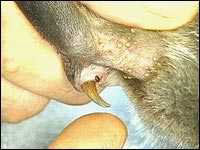
(Ornithorhynchus anatinus)
Platypus
and echidna
are the only egg-laying mammals in the world -
called
monotremes
(this word means 'one holed' referring to the
fact that their urinary tract, anus and
reproductive tract are all in one)
Platypus are readily identified by their
streamlined body, webbed feet, broad tail and
characteristic muzzle or bill which is soft and
pliable.
An adult platypus
is from 45 cm to 60 cm in length and may weigh
up to 2.7 kg, with females generally smaller
than males. Its usual colouration is deep brown
on the back and sides of the head, body and
upper surfaces of the limbs. The underside is a
golden colour although silky grey is not
uncommon. They have two layers of fur - a dense
waterproof outercoat and a grey woolly underfur
to provide much needed insulation. The fur on
the broad flat tail is coarse and bristly. They
have a smooth swimming action together with a
low body profile and no visible ears, making
them easily recognisable in the water. It could
only be mistaken for a
water rat,
but these have a long thin tail with a white
tip.
The
platypus is found in eastern Australia.
They
live alongside freshwater rivers or lakes, and
create burrows for shelter and protection. They
are active mainly at nighttime hours, and use
their webbed feet for swimming. When swimming
the platypus has its eyes shut. They swim
underwater for 2 minutes, before returning to
the surface for oxygen. They can however stay
underwater for up to 10 minutes, though due to
their natural buoyancy, they need to be
underneath another object to do this.
Monotremes are the only mammals known to have
the sense of
electroreception:
they locate their prey in part by detecting
electric fields generated by muscular
contractions. The platypus' electroreception is
the most sensitive of any monotreme.
Platypuses feed on insect larvae, worms or other
freshwater insects. They do so mainly at night,
by the use of their bill. They turn up mud on
the bottom of the lake or river, and with the
help of their electroreceptors located on the
bill, find many insects and freshwater insects.
They store their findings in special pouches
behind their bill, and are consumed upon
returning to the surface.
The
male platypus have a hollow spur
about 15 milimetres in length on the inside of
both hind legs. This in turn is connected to a
venom gland, and the platypus uses this spur to
defend itself against predators. 
The male platypus has venom strong enough to
kill a small dog, or cause excruciating pain
among humans.
Since only the male platypus has this venomous
spur, and the gland peaks during mating season,
many suggest it is normally used in aggressive
encounters between other male platypus.
Breeding occurs during spring
but
is generally earlier in the north of Australia
than in the south. Mating takes place in the
water and after 12 to 14 days, between 1 and 3
eggs are laid in a nesting burrow constructed by
the female.
The
eggs are laid inside burrows and are incubated
between the belly and the tail of the female and
hatch after 10 to 12 days. Like the echidna,
the platypus lacks nipples and milk from the
mammary glands oozes out through ducts at two
areas on the abdomen. It is believed that the
hair around these areas acts as teats that
allows the young to suck the milk. By six weeks
the young are furred, have their eyes open and
may leave the burrow for short intervals and
even enter the water. When four to five months
old the young are weaned.
Top of page


